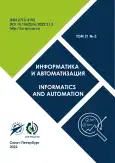Volume 21, Nº 3 (2022)
Robotics, automation and control systems
Trajectory Planning Algorithms in Two-Dimensional Environment with Obstacles
Resumo
This article proposes algorithms for planning and controlling the movement of a mobile robot in a two-dimensional stationary environment with obstacles. The task is to reduce the length of the planned path, take into account the dynamic constraints of the robot and obtain a smooth trajectory. To take into account the dynamic constraints of the mobile robot, virtual obstacles are added to the map to cover the unfeasible sectors of the movement. This way of accounting for dynamic constraints allows the use of map-oriented methods without increasing their complexity. An improved version of the rapidly exploring random tree algorithm (multi-parent nodes RRT – MPN-RRT) is proposed as a global planning algorithm. Several parent nodes decrease the length of the planned path in comprise with the original one-node version of RRT. The shortest path on the constructed graph is found using the ant colony optimization algorithm. It is shown that the use of two-parent nodes can reduce the average path length for an urban environment with a low building density. To solve the problem of slow convergence of algorithms based on random search and path smoothing, the RRT algorithm is supplemented with a local optimization algorithm. The RRT algorithm searches for a global path, which is smoothed and optimized by an iterative local algorithm. The lower-level control algorithms developed in this article automatically decrease the robot’s velocity when approaching obstacles or turning. The overall efficiency of the developed algorithms is demonstrated by numerical simulation methods using a large number of experiments.
 459-492
459-492


Artificial intelligence, knowledge and data engineering
Application of a Compartmental Spiking Neuron Model with Structural Adaptation for Solving Classification Problems
Resumo
 493-520
493-520


Experimental Study of Language Models of "Transformer" in the Problem of Finding the Answer to a Question in a Russian-Language Text
Resumo
 521-542
521-542


Data Analysis and Visualization in the Tasks of the Project Solutions Multicriteria Optimization
Resumo
 543-571
543-571


Machine Learning in Base-Calling for Next-Generation Sequencing Methods
Resumo
 572-603
572-603


Mathematical modeling and applied mathematics
Dynamic Model of Population Invasion with Depression Effect
Resumo
 604-623
604-623


Numerical Solution of the Problem of Filtering Estimates Information Impact on the Electorate
Resumo
 624-652
624-652











